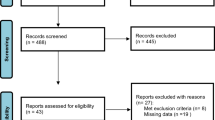Abstract
Objective
This retrospective case–control study was undertaken to assess the impact of a malleable stylet application on embryo transfer (ET) outcome.
Methods
The Wallace malleable stylet was used when the soft inner catheter could not negotiate the internal os during ultrasound-guided ET. Patients having an age ≤37 years, with three embryos replaced were included in the analysis. Implantation rate, clinical pregnancy rate and live birth rate were the main outcome measures.
Results
The Wallace malleable stylet was applied in 164 (29.6%) of the 553 ETs evaluated. Implantation rate, clinical pregnancy rate and live birth rate showed a 5.6% (19.4% vs. 13.8%), a 10.8% (41.9% vs. 31.1%) and a 9.9% (37.3% vs. 27.4%) absolute difference, respectively, in favor of ETs not requiring the stylet. These differences were statistically significant (P < 0.05).
Conclusions
ETs requiring stylet are associated with lower implantation, clinical pregnancy and live birth rates.
Similar content being viewed by others

References
Mains L, Van Voorhis BJ. Optimizing the technique of embryo transfer. Fertil Steril. 2010;94:785–90.
Mansour R, Aboulghar M, Serour G. Dummy embryo transfer: a technique that minimizes the problems of embryo transfer and improves the pregnancy rate in human in vitro fertilization. Fertil Steril. 1990;54:678–81.
Buckett WM. A review and meta-analysis of prospective trials comparing different catheters used for embryo transfer. Fertil Steril. 2006;85:728–34.
Brown JA, Buckingham K, Abou-Setta A, Buckett W. Ultrasound versus ‘clinical touch’ for catheter guidance during embryo transfer in women. Cochrane Database Syst Rev. 2007;24:CD006107.
Nygren KG, Sullivan E, Zegers-Hochschild F, Mansour R, Ishihara O, Adamson GD, de Mouzon J. International Committee for Monitoring Assisted Reproductive Technology (ICMART) world report: assisted reproductive technology 2003. Fertil Steril. 2011;95:2209–22. 2222.e1–17.
Nielsen IK, Lindhard A, Loft A, Ziebe S, Andersen AN. A Wallace malleable stylet for difficult embryo transfer in an in vitro fertilization program: a case–control study. Acta Obstet Gynecol Scand. 2002;8:133–7.
Rienzi L, Ubaldi F, Anniballo R, Cerulo G, Greco E. Preincubation of human oocytes may improve fertilization and embryo quality after intracytoplasmic sperm injection. Hum Reprod. 1998;13:1014–9.
Karande V, Hazlett D, Vietzke M, Gleicher N. A prospective randomized comparison of the Wallace catheter and the Cook Echo- Tip(R) catheter for ultrasound-guided embryo transfer. Fertil Steril. 2002;77:826–30.
van Weering HG, Schats R, McDonnell J, Vink JM, Vermeiden JP, Hompes PG. The impact of the embryo transfer catheter on the pregnancy rate in IVF. Hum Reprod. 2002;17(3):666–70.
Silberstein T, Weitzen S, Frankfurter D, Trimarchi JR, Keefe DL, Plosker SM. Cannulation of a resistant internal os with the malleable outer sheath of a coaxial soft embryo transfer catheter does not affect in vitro fertilization-embryo transfer outcome. Fertil Steril. 2004;82(5):1402–6.
Hearns-Stokes RM, Miller BT, Scott L, Creuss D, Chakraborty PK, Segars JH. Pregnancy rates after embryo transfer depend on the provider at embryo transfer. Fertil Steril. 2000;74(1):80–6.
Lesny P, Killick SR, Tetlow RL, Robinson J, Maguiness SD. Embryo transfer—can we learn anything new from the observation of junctional zone contractions? Hum Reprod. 1998;13(6):1540–6.
Fanchin R, Righini C, Olivennes F, Taylor S, de Ziegler D, Frydman R. Uterine contractions at the time of embryo transfer alter pregnancy rates after in-vitro fertilization. Hum Reprod. 1998;13(7):1968–74.
Conflict of interests
The Authors declare no potential conflict of interest.
Author information
Authors and Affiliations
Corresponding author
Additional information
Capsule
Embryo transfer represents a crucial step in assisted reproduction procedures. We found that difficult embryo transfers requiring the use of a malleable stylet result in a poorer ART outcome
Rights and permissions
About this article
Cite this article
Tiboni, G.M., Colangelo, E.C., Leonzio, E. et al. Assisted reproduction outcomes after embryo transfers requiring a malleable stylet. J Assist Reprod Genet 29, 585–588 (2012). https://doi.org/10.1007/s10815-012-9743-9
Received:
Accepted:
Published:
Issue Date:
DOI: https://doi.org/10.1007/s10815-012-9743-9


